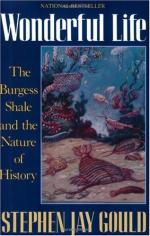
|
| Name: _________________________ | Period: ___________________ |
This test consists of 5 multiple choice questions, 5 short answer questions, and 10 short essay questions.
Multiple Choice Questions
1. What was Opabinia's frontal nozzle not?
(a) A proboscis.
(b) Part of its head.
(c) A second mouth.
(d) A carapace.
2. How does Gould begin Chapter 2: "A Background for the Burgess Shale"?
(a) Explaining the last chapter's conclusion.
(b) Explaining how scientists divide up historical epochs.
(c) Explaining what the Burgess Shale represents.
(d) Explaining which animals are in the Burgess Shale.
3. What do the levels range from in the taxonomy of life?
(a) Phyla to classes.
(b) Kingdom to species.
(c) Phyla to species.
(d) Orders to genera.
4. Where was Opabinia quoted to belong?
(a) Among the crustaceans.
(b) Nowhere among the known animals.
(c) With the arthropods.
(d) In the third genus.
5. What does Gould focus on to bring the Burgess Shale into clear view?
(a) Whittington's insight.
(b) Des Collin's insight.
(c) Opabinia's dissection.
(d) Technical perfection
Short Answer Questions
1. Which genus was Whittington focused on classifying in Chapter Three?
2. How many general stages of fauna are between the two faunas both eukaryotic and of the Burgess Shale?
3. How many of these designs survived the first great extinction?
4. Of Whittington's team, who was more methodologically conservative?
5. When did Whittington begin studying Opabinia?
Short Essay Questions
1. What was the difference between Simon Conway Morris and Whittington in the way that they worked?
2. What did Whittington find Opabinia to actually be?
3. How did Whittington try to uncover the bodily appendages of Opabinia?
4. What did Leif Størmer's "Treatise on Invertebrate Paleontology" describe?
5. How does Gould begin Chapter 2: A Background for the Burgess Shale?
6. What dominant paradigm about the Burgess fossils was Whittington pressured to conform to?
7. What sorts of new procedures did Whittington's team use?
8. What did Leif Størmer decide to do in contrast to Walcott?
9. Why is the Burgess Shale acknowledged as the most significant collection of fossils yet discovered?
10. What did Stephen Jay Gould desire to use the Burgess Shale for?
|
This section contains 538 words (approx. 2 pages at 300 words per page) |

|




